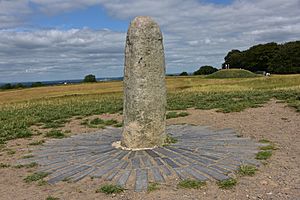Lia Fáil facts for kids
The Lia Fáil is a famous stone in Ireland. It's also called the Stone of Destiny or the Speaking Stone. You can find it on the Hill of Tara in County Meath. Long ago, this stone was used to crown the High Kings of Ireland. Legends say that kings were crowned on it until around the year 500 AD.
Quick facts for kids Lia Fáil |
|
|---|---|
| Speaking Stone, Coronation Stone | |

The stone currently standing on the Hill of Tara identified with the historical Lia Fáil
|
|
| Type | Standing stone |
| Etymology | Irish: Stone of Fál (Ireland/destiny) |
| Location | Hill of Tara |
| Elevation | 155 metres (509 ft) |
| Height | 1 metre (3 ft 3 in) |
| Original use | coronation stone |
| Lua error in Module:Location_map at line 420: attempt to index field 'wikibase' (a nil value). | |
Contents
Where Did the Lia Fáil Come From?
There are many old stories about how the Lia Fáil arrived in Ireland. These stories are part of Irish mythology.
The Tuatha Dé Danann Story
One popular legend comes from a book called the Lebor Gabala, written around the 11th century. It says that a special group of magical people, the Tuatha Dé Danann, brought the stone to Ireland.
The Tuatha Dé Danann traveled to "Northern Isles" to learn magic and skills. They visited four cities: Falias, Gorias, Murias, and Findias. From each city, they brought a special treasure to Ireland. The Lia Fáil came from the city of Falias.
The other three treasures were:
- The Claíomh Solais (Sword of Light)
- The Sleá Bua (Spear of Lugh)
- The Coire Dagdae (The Dagda's Cauldron)
The Stone of Scone Connection
Some old Scottish writers, like John of Fordun and Hector Boece, thought the Lia Fáil was the same as the Stone of Scone in Scotland.
They believed the Lia Fáil left Tara around 500 AD. This happened when the High King of Ireland, Murtagh MacEirc, loaned it to his great-uncle, Fergus. Fergus needed it for his own crowning in Scotland.
Fergus's kingdom, Dál Riata, included parts of Ireland and western Scotland. After Fergus was crowned, he and his group were caught in a big storm and sadly died. The stone stayed in Scotland. This is why Murtagh MacEirc is known as the last Irish King crowned on the Lia Fáil.
However, some historians point out something interesting. While the Scottish story says the Stone of Scone came from Ireland, the Irish stories sometimes say the Lia Fáil came from Scotland!
The Princess Tea Tephi Legend
Another old Gaelic myth connects the Lia Fáil to the Stone of Scone. This story says the sacred stone arrived in Ireland by ship around 580 BC. It came with Eochaidh, a prince, Princess Tea Tephi, and a scribe named Simon Brauch.
Princess Tea also had an ancient harp. Some believe it came from the House of David. The three of them brought the stone to the Hill of Tara. Princess Tea later married High King Eochaidh. They had met in Jerusalem. Eochaidh is said to have found the stone in Jerusalem before the Babylonians invaded.
It is believed that all future Irish High Kings and British Monarchs crowned by the stone tried to show they were related to Eochaidh and Tea Tephi. Eochaidh is thought to be buried in a very old tomb called Cairn T at Loughcrew.
What Magical Powers Did the Stone Have?
People believed the Lia Fáil had special magical powers.
- It was said to roar with joy when the rightful High King of Ireland placed his feet on it.
- The stone was also thought to make the king younger and give him a long reign.
According to the Lebor Gabála Érenn, a hero named Cú Chulainn once split the stone with his sword. This happened because it didn't cry out for his friend, Lugaid Riab nDerg. After that, the stone supposedly never cried out again, except for Conn of the Hundred Battles. Legend also says it roared for Brian Boru when he was crowned in 1002.
Why Is Ireland Called Inis Fáil?
The Tuatha Dé Danann gave Ireland the name Inis Fáil because of this stone.
- Inis means "island."
- Fál is an old Irish word that can mean "hedge," "enclosure," "king," or "ruler."
- So, Lia Fáil can mean "Stone of Ireland."
Because of this, Fál became an ancient name for Ireland. You might see Inisfail used as another name for Ireland in old Irish poems from the 1800s and early 1900s. For example, Aubrey Thomas de Vere wrote a poem called Inisfail in 1863.
The phrase Fianna Fáil means "the warriors of Ireland" or "the soldiers of destiny." This term has been used for:
- The Irish Volunteers (a group of soldiers).
- The cap badge of the Irish Army.
- The first line of the Irish national anthem, Amhrán na bhFiann.
- The name of a major political party in Ireland, called Fianna Fáil.
Damage to the Stone
Sadly, the Lia Fáil has been damaged a few times.
- In June 2012, someone hit the stone with a hammer in 11 different places.
- In May 2014, it was damaged again. Green and red paint was poured all over the stone, covering more than half of it.
See also
 In Spanish: Lia Fáil para niños
In Spanish: Lia Fáil para niños

